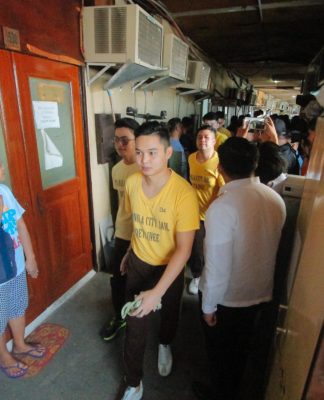IT COULD have been a perfect night for crime, but somebody wiser and braver wrote a happy ending for what could have been another sob story.
The taxi driver was plying the road for late-night passengers when he was flagged down by a distressed and frantic kolehiala who had just been gang-raped by her fellow passengers in a jeepney. The driver immediately took her in and chased the suspects. Because of driver’s initiative, the police caught the girl’s attackers, who are now paying the stiff price in jail.
This story may already have been immortalized by the media, but I’m writing about it again because it was told to me by the driver himself.
My classmates and I were in a taxi to attend a wake. It was nine in the evening, and we had a hard time getting a ride because the taxi drivers were either unwilling or unreasonable.
But this driver was surprisingly amiable and nice. When one of my friends asked for candies, he politely offered yellow Maxxes to us. It’s funny when I remember it now. I even suspected, for a split second, that the candies he was offering were drugs.
My suspicions were aroused when he glanced at my friend from his rear view mirror, and casually remarked, “You look like someone I know.”
“Who?” my friend asked.
“The college student who was raped some time ago.”
We all laughed nervously. “Yes, you really look like her,” the driver went on. “I came across her once and she pleaded with me to chase her attackers who was escaping in a jeep.”
Doubt
We did not believe him at first. Sensing our doubt, he reached into the glove compartment for a thick sheaf of papers and gave it to my friend sitting in the front. “Look, here is the evidence. That case was all over the papers, radio and TV. You couldn’t have missed it.”
My friend read the photocopied clippings and photos, then carefully scrutinized the driver’s face, then the photos. “Kayo nga po itong nasa diyaryo!” she exclaimed.
By that time, all of us at the back were jostling and craning our necks to see the clippings and get a better view of the driver’s face, to see if he was really saying the truth. After all, it’s so easy to concoct tall stories nowadays.
We listened to his story as he weaved in and out of the evening traffic. He recounted how his helping the poor girl had unknowingly placed him in the limelight. Hailed as a modern-day hero, he was given good deal of media and political exposure. “They rewarded me money, the works,” he said without a trace of smugness. He even received a citation of merit from the TV program Emergency on GMA 7. “Some politicians even promised me the stars and the moon,” he chuckled, shaking his head. “But of course, those promises never materialized.”
When we asked what made him do it, he simply replied: “It was more like reflex. Bugso ng damdamin lang. And I had thought at that time, what if that poor girl was my daughter? If I could do something to help, I would.”
I admire this taxi driver because it takes guts to lift a finger. I am also relieved that there are still people who care about what happens around them. I have known more horrible sob stories. A man leaving his uncle alone to be stabbed to death by a drug-crazed gang; the same cowardly man unwilling to testify in the case of his dead uncle.
These may sound like “telenovela” sob stories, but they do happen in real life. It’s up to us to give our stories either tragic or happy endings.
* * *
I love stories. I put them down on paper every chance I get because, as writer Kerima Polotan says it. “There is a truth here somewhere reserved for me, I hope I do not miss it.”
If it was a harmless joke or a sarcastic jibe, I may never know. But when some acquaintances observed me to be watching an interesting scene and said, all the while giggling, “Most likely you are going to write about that again!”
Of course, I am going to. Where else would I draw my stories, but from real life?
* * *
What happens when your patient has every known disease, from heart complications, diabetes, renal failure, bed ulcers, to difficulty in breathing? When he is connected to all kinds of tubes—be it oxygen tubes, a catheter for the urine to come out, intravenous fluid lines, and a mechanical ventilator? Then when you are made to coax sense out of all of this bedlam, you just get lost and confused in a maze of manila papers, thick books, and lengthy debates on whether nausea and vomiting leads to dehydration, or vice versa.
After the blood shedding because in our thesis, here comes another “silent killer”—the case protocol. In this subject, you either celebrate because you have assiduously studied your lesson in the earlier years, or go half-mad and rant about the time you spent sleeping, using your thick books as your pillow.
The latter is happening to me. For even with my study habits, my “artist’s temperament” is in full blast. As in writing, I study only when in the mood. Which is more seldom than often.
But it’s not too late to catch up, to see the “truth reserved for me.”
* * *
Christmas is the right time for changing skewed storylines into good ones. May we all see beyond the bright lights, dizzying parties, good food and loud music, and put order in our storylines. Happy holidays!














